
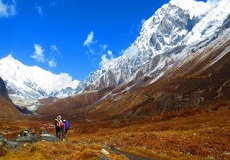
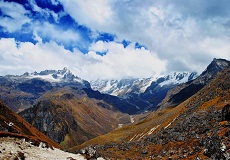

![]()
Dzongri nestled high in the Himalayas between China to the north, Bhutan to east and Nepal to eastern frontier, Sikkim is often described as a land of unparalleled scenic beauty. A hidden gem in the north-eastern region of the country, trekkers on this trek gets introduced to the fascinating beauty of picturesque landscapes, exotic wildlife and rolling wildlife. Dzongri trek is the small trek option of the Goechala Trek. Those who are very much passionate about trekking in the Himalayas, they can choose to trek on the hilly terrains of the western region of Sikkim Hills to Dzongri. For the trekkers who want to explore more in a short duration the Dzongri trek is the most ideal option. To trek the route of Dzongri, one needs to avail the route by walking only. At every turning you will be closer to unfold the mysteries of this region. From New Jalpaiguri Railway Station cars and jeeps are available that reaches upto Yuksom. Yuksom is a small hamlet of West Sikkim, an enthralling drive through the winding terrains and narrow passes of Kalimpong will take you to Yuksom, from here the trek to Dzongri begins. Yuksom is the base of West Sikkim’s most popular trekking region, Dzongri and is also of historical importance to the Sikkimese. Yuksom literally means ‘meeting place of the three lamas’. In the beginning of seventeenth century a rift between different factions of Buddhist sects in Tibet forced the Red Hat Sect to seek refuge in Sikkim. Lama Lhatsun Chempo, on his journey to Sikkim, arrived at Norbugang in Yuksom, where he met two other lamas, Sempa Chempo and Rinzing Chempo and began converting the people into their faith.
A one day rest and acclimatization at Yuksom is necessary to travel such a long distance on the hills. All necessary equipment needs for trekking are available from Yuksom. One can also take these equipment on rented basis from the locals, those who give the equipment on rent. Yuksom is about 200 km from New Jalpaiguri railway station, times takes about 7 to 8 hours. On the way to Yuksome one can make a halt at Jorethang for breakfast or lunch. As it almost becomes evening to reach Yuksom. Yuksome is hamlet that remains covered with fog and the temperature here is very cold, a wind constantly blows here. On a single day journey to reach Yuksome one needs to travel to a high altitude of about 1780 meter above sea level, which is about 6000 ft. While one reach Yuksome, one will get a clear idea that a long distance has been traveled in a single day journey. At Yuksome, arrangements of very few homestays and trekkers hut are available for the tourists. From Yuksome spectacular view of Mt. Kanchenjunga is clearly visible on a clear day. For Dzongri trek one need to arrange for the essential products those includes dry foods, woods for lighting and cook from Yuksom. On the very next day you need to leave Yuksom as early as possible and starts journey for Bakhim. Bakhim is at an altitude of about 3000 meter which is about 9800 ft above sea level and distance is about 15 km. The trekking route to Bakhim is through Kanchenjunga Wild life Sanctuary. After an hour or so we cross the Paha Khola Bridge, (1,733 meter – 5685 ft.).
From Yuksome to Bakhim there are four hanging brides which you need to cross to reach Dzongri. To cross each bridge at first a trek to the downward section of the hills is needed and then again a route which is of same distance is to the upward direction, time takes to climb to the upwards section of the hills is much more than it takes to trek to the downward side. In this way four times upward and downward trek needs to cross the bridges. On the trekking route one will come across numerous long stretches and thick greenness of Oak, Chestnuts, Maple, Pine, Magnolia and Rhododendron. To the downward side flows a river. At the end of the route “Prek Chi” comes and touches the foot. Locally the word “Prek Chi” means river. At Bakhim there are only very few trekkers huts available for the tourists or trekkers to spend the night. Foods available only noodles, chicken and egg. On the next day at early morning again one should start early for the trek towards Dzongri, distance is about 12 km. Dzongri is at an altitude of about 4030 meter i.e. 13200 ft. On the way the next destination is Sokhla. Upto Tsokha the route is of log woods on the muddy road. Tshoka is home to a colony of Tibetan refugees who have erected a small monastery by a small lake. A fairly steep climb above Tshoka takes you into beautiful rhododendron forests, and you continue along a well-defined uphill path to Phedang (approx. 2/3 hours from Tshoka). Once you cross Tsokha, the route is through the dense forest. Dense greenery of Pine, Oak, Fir and Rhododendron. Here the sunlight hardly enters through these trees. Beneath the feet thick mosh and fern those spread all over and are getting crushed at every single step. At someplace you will get to see clusters of Orchids that blossom up here. Just before reaching Dzongri, you need to cross a small hilltop named Deorali Top. As soon as one crosses Deorali Top, you will get see wide open landscape of Dzongri. At Dzongri, staying accommodations are done only in tents. On the next day a journey to Dzongri Top, the altitude is about 250 meter near about 850 ft from the landscape of Dzongri. Dzongri top is ideal spot for Sunrise. From here you will get to see Mt. Kanchenjunga (8585 meter – 28167 ft), Mt. Kabru South (7317 meter – 24006 ft), Mt. Kabru North (7338 meters – 24075 ft), Mt. Simvo (6811 meters – 22346 ft), Mt. Pandim (6691 meters – 21953 ft), Mt. Kabru Forked (6108 meters – 20040 ft), Mt. Rathong (6679 meters – 21913 ft), Mt. Kumbhakarna (Janoo) (7710 meters – 25296 ft), Mt. Kokthang (6147 meters – 20168 ft), Mt. Goecha Peak (5127 meters – 16821 ft) and Mt. Frey Peak (5830 meters – 19128 ft) and the sunrise above the peaks is awesome. Here one can see nature changes its colour from red- pink- orange- white. On return journey one can take the same route. But trekking to such a high altitude requires physical fitness and endurance.
Best Time to visit: The best time to visit March – April and October – November, in December – February is becomes quite troublesome to trek in this region as the whole remains covered with thick snow everywhere and the route becomes almost unapproachable. Though at this time of the year some expeditions are carried out in here under the supervision of trained professionals. In the monsoon it is better to avoid the trekking, as because in the mid June – mid September the road becomes slippery and there are chances of landslides and road block by boulders are very common.
How to reach: From Sealdah, Howrah and Kolkata station several trains are available that reaches up to new Jalpaiguri. From New Jalpaiguri by shared or hired cars up to Yuksom and from Yuksom the trek route starts. Yuksom can also be reached from Gangtok, Tashiding, Pelling by hired cars or jeeps. For share jeeps the availability becomes very limited after 1 PM. The nearest airport is Bagdogra, from there hire cars are available for Yuksom.
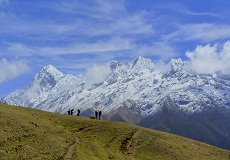
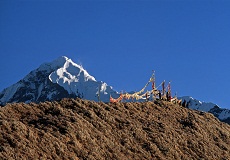
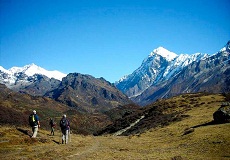
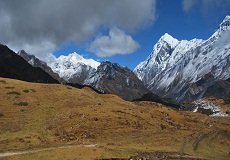

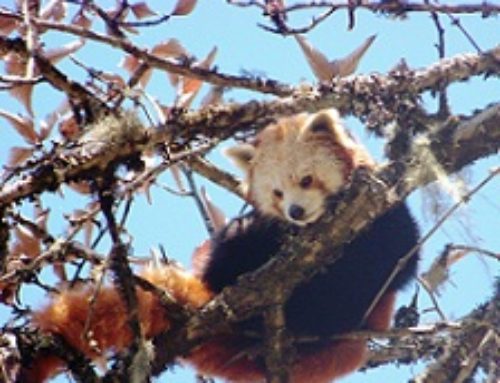
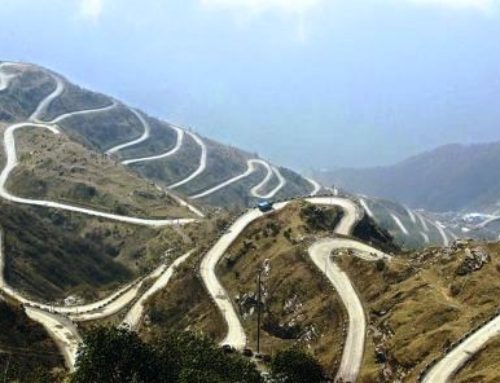


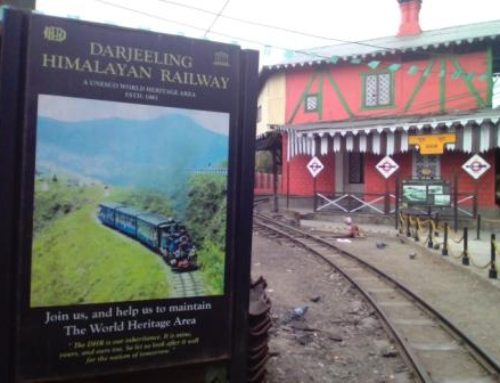
Leave A Comment
You must be logged in to post a comment.